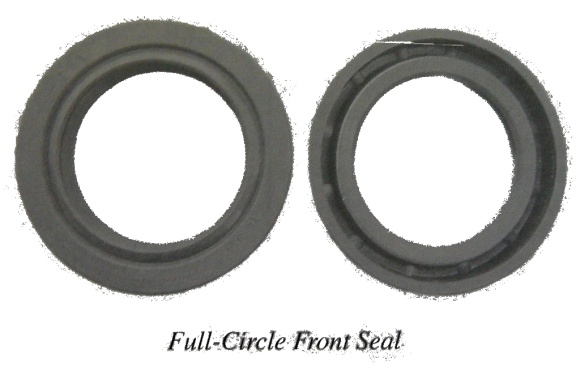Front Rope Seals
The front crankshaft seals available are much like they were a few years ago. They are the white, cut-to-length ropes and the full circle lip seals.
The white rope material was asbestos with a rubber binder in the old days. Now the fibers are acrylic and/or fiberglass, still with a rubber binder. Many have a rubber or graphite cord or core for more dimensional stability.
These are mostly, if not all, cut-to-length and should not be trimmed. They should be pre-soaked in oil, then "ironed" into the seal cavity. I use a large lightly fluted screw driver handle.
When they are properly ironed into place, each end will be 1/16 – 1/8" proud. If the ends are not even, remove the seal to reposition it, and iron it back into the cavity until you get it right.
Use a light grease on the seal surfaces that contact the crankshaft pulley or other seal surface.

Full circle lip seals
There are also a number of full circle lip seals available for the front of our flathead V-8's. Some are adaptations, some are purpose made. Some have the correct OD, some are installed first into a metal adaptor.
These full circle lip seals are lubed and installed on the seal surface on the crankshaft, or on the crankshaft pulley. Insure that the primary lip faces the inside of the engine. There may be a secondary lip that faces forward. Its function is to keep dust and dirt from the primary lip seal.
The scroll that is on most of the stock seal surfaces is not needed for the rubber lip seal and may wear the seal prematurely. On the 49 and earlier engines, there are seal surface repair sleeves that may be installed over the old surface. These have a smooth OD.
On the 50 and later engines, Ford used a separate seal surface that presses on to the front of the crankshaft. It can be replaced with a smooth OD seal surface. The seal surface repair sleeves may also be used on the later engines.
Even though the Ford part number for the front seals is the same for Model A through 1953 V-8, the full circle sleeves don't always work in Model A's. The front seal cavity in the Model A is frequently quite out of round. Even though the volume of the cavity may be similar to the V-8's cavity volume, the steel or aluminum structure of the full circle seal is not nearly as flexible as the rope packing.
In any of the full circle lip seal installations, the front of the pan gaskets should be trimmed to match the seal OD.
Rear Main Seals
As it happens, this out of roundness at the cavity is the reason that there has not been much success in marketing a lip type rear main seal. The upper and lower cavities frequently have different sizes, and are also different sizes in different year ranges.
Some very good people have spent time and money on this. Perhaps there will be lip type rear main seals, but I know of none that are viable now.
There is a new rear seal material on the market however. The early reports on it are very good. They do not appear to be as installation technique sensitive as the older white rope seals.
It is a combination of graphite and Kevlar fibers marketed as "Graphtite" TM. They come with instructions, a trimming guide and a special knife. Yes, they must be trimmed.
Careful installation of crankshaft seals will let you enjoy your V-8 without the drips.
